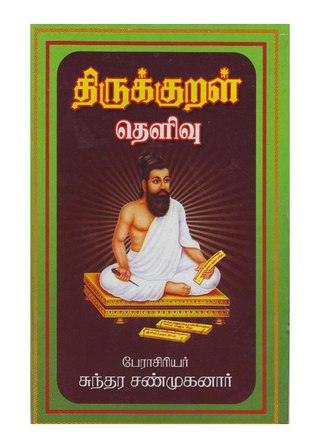Kural
Classic Tamil-language sacred poetic text From Wikipedia, the free encyclopedia
The Tirukkuṟaḷ or shortly the Kural is a classic Tamil language text. It has 1,330 short couplets (two-line poem parts), or kurals, of seven words each.[4]
 | |
| Author | Valluvar |
|---|---|
| Original title | திருக்குறள் |
| Working title | Kural |
| Country | India |
| Language | Old Tamil |
| Series | Eighteen Lesser Texts |
| Subject | |
| Genre | Poetry |
| Set in | Probably after the Sangam era (c. 500 CE or earlier) |
Publication date | 1812 (first known printed edition, older palm-leaf manuscripts exist)[3] |
Published in English | 1794 |
Original text | திருக்குறள் at Tamil Wikisource |
| Translation | Tirukkuṟaḷ at Wikisource |
Tamil Wikisource has original writing related to this article:
The text is divided into three books with aphorisms (sayings) on virtue, wealth and love.[1][5][6] It is thought as one of the greatest works ever written on ethics and morality. It is also known for its all-inclusiveness and secular nature.[7][8]
History
People say Thiruvalluvar wrote the work. The text has been dated between 300 BCE and the 5th century CE. [9]
The Kural text is among the earliest systems of Indian epistemology (way of thinking of knowledge) and metaphysics (way of thinking of reality and being). The Kural is traditionally praised with epithets such as "the Tamil Veda" and "the Divine Book".[10][11]
Contents
Written on the ideas of ahimsa (non-violence),[12][13][14][15][16] it draws attention to non-violence and moral vegetarianism as good things for a person to do.[17][18][19][20][21][a] It highlights truthfulness, controlling your emotions and reactions, thankfulness, hospitality, kindness, goodness of one's wife, duty, giving, and so forth.[22] It covers many social and political topics such as kings, ministers, taxes, justice, forts, war, greatness of armies and soldier's honor, death sentence for the wicked, agriculture, education, not drinking alcohol and things that make people drunk or high.[23][24][25] It has chapters on friendship, love, sexual unions, and home life.[22][26] The text permanently redefined the cultural values of the Tamil land.[27]
Reputation
The Kural has been liked and respected by experts from ethical, social, political, economic, religious, philosophical, and spiritual fields.[28] These include Ilango Adigal, Kambar, Leo Tolstoy, Mahatma Gandhi, Albert Schweitzer, Ramalinga Swamigal, V. O. Chidambaram Pillai, Karl Graul, George Uglow Pope, Alexander Piatigorsky, and Yu Hsi. The work remains the most translated, the most referred-to, and the most cited of Tamil literary works.[29]
The text has been translated into at least 40 languages. This made it one of the most translated ancient works. Ever since it was printed for the first time in 1812, the Kural text has never been out of print.[30] Its author is praised for selecting the best virtues found in the known books and showing them in an manner that most people understand.[31] The Tamil people and the government of Tamil Nadu have long revered and celebrated the text.[19]
Citations
References
Wikiwand - on
Seamless Wikipedia browsing. On steroids.
